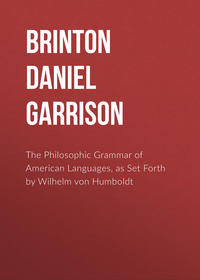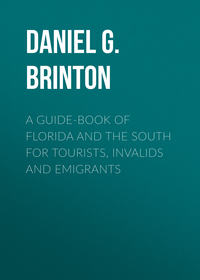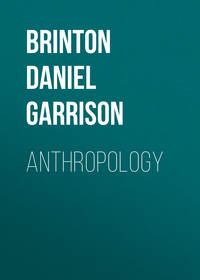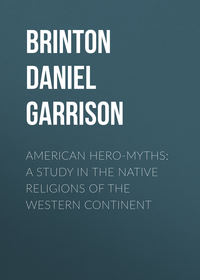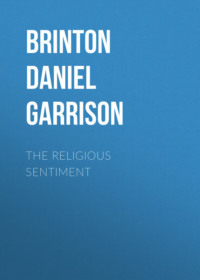 полная версия
полная версияThe American Race
Tlinkit mythology is rich, having a coherent creation and deluge myth, the principal figure in which is Jelchs, the raven. He is the Promethean fire-bringer, and sets free the sun, moon and stars from their prisons. The religious rites are in the hands of priests (shamans), who as usual exert a great and injurious influence.121
The Haidahs, who dwell on Queen Charlotte Islands and Prince of Wales Archipelago, are probably a distant branch of the Tlinkit, though the affinity has not been clearly established, so they are officially classed as the Skittagetan stock, from the Skidegate dialect of the coast. In culture and appearance they resemble the Tlinkits, having similar mechanical skill. Their canoes and their intricate carvings, especially totem-posts and pipes of black slate, are celebrated products of the northwest coast.
The above and other tribes of British Columbia and Washington, the Tshimshian, the Kwakiutl, the Nootka, Salish, Chinook, etc., are so much alike physically that Dr. Boas, who has carried out the most recent and thorough examination of them, observes that no physical distinctions can be drawn between them.122 In some the hair is slightly wavy; in others the nose is aquiline or flatter; the heads of several are artificially deformed, etc.; but these differences do not characterize whole stocks. All have a great respect for wealth, and consider its accumulation the chief object of life. Among them all, women are honored for their chastity and industry, men for their skill in hunting and fishing, and for their bravery in war. Their character is generally sombre, and vanity and servility are prominent faults. The animal totemic system generally prevails, the child among the Salish and Kwakiutl following the father’s gens. The communities are divided into social strata, as common people, middle class and chiefs. A favorite method to obtain popularity is to give a potlatch—a great feast, at which the host makes expensive presents to the guests, and thus becomes as it were their creditor to the amount of his disbursement.
The Salish, who are distinctively known as Flatheads, though the custom of deforming the cranium is not confined to them, occupied a large tract in northern Washington and British Columbia.
The principal contribution of the Chinooks to modern life has been the “Chinook jargon” which has become the trade language of the coast. It is a curious medley of words, and has been recently made the subject of an interesting study by Mr. Horatio Hale.123
The Sahaptins or Nez Percés, with their affiliated tribes, occupied the middle and upper valley of the Columbia and its affluents, and also the passes of the mountains. They were in contiguity with the Shoshonees and the Algonkin Blackfeet, thus holding an important position, intermediate between the eastern and the Pacific tribes. Having the commercial instinct of the latter, they made good use of it, and every summer carried the various products of the coast, as shells, carved pipes, hammered copper, etc., far down the Missouri, where they exchanged them for the wares of the tribes there situate.
Of the numerous other linguistic stocks on the coast it will be sufficient for me to append the classification adopted by the Bureau of Ethnology at Washington.
NORTH PACIFIC COAST STOCKS
(From north to south.)Tlinkit or Koloschan, in southern Alaska.
Haidah or Skittagetan, on Queen Charlotte Islands.
Dialects—Masset, Skidegate, etc.
Tshimsian or Chimmessyanian, on Nass and Skeena rivers.
Dialects—Chimmessyan, Nasqua.
Kwakiuootl or Haeltzukian, on Gardiner’s Channel.
Dialects—Heiltsuk, Kwakiutl, Quaisla.
Nutka or Wakashan, on western coast of Vancouver Island.
Dialects—Aht, Nootka, Wakash.
Chinook or Chinookan, Columbia river to Dalles; Pacific coast to Shoalwater Bay; south to Tillamuk Head.
Salish, Admiralty Inlet to Spokane river.
Dialects—Bilcoola, Kawitschin, Lummi, Samie.
Chimakuan, Puget Sound, Port Townsend to Port Ludlow.
Kutenay or Kitunahan, head-waters of Columbia.
Sahaptin or Sahaptanian, middle affluents of Columbia.
Dialects—Klikatat, Nez Percé, Sahaptani, Wallawalla, Yakama.
Wayilaptu or Waiilaptuan, near mouth of Wallawalla river.
Yakonan, coast of Oregon from Yaquina river to Umpqua river.
Kalapooian, on the Wilamette river. Kusan, about Coos Bay.
Palaihnihan or Achomawi, on Pit river.
Takilman, on upper Rogue river.
Sastean or Shasta, on upper Klamath river.
Lutuamian or Modoc, on Klamath Lake and Sprague river.
Quoratean or Ehnek, on lower Klamath river to junction of Trinity river.
Yukian, in Round Valley, California.
Yanan or Nozi, Lassen Butte and Round Mountain.
Pujunan or Maidu, east bank of Sacramento river.
Kulanapan or Pomo, Russian river and adjacent coast.
Copehan or Wintun, on Trinity river.
Weitspekan or Rurok, lower Klamath river from Trinity river down.
Chimarikan, on New river and Trinity river.
Wishoskan, on Humboldt Bay.
Mariposan or Yokuts, on Kings river and Tulare Lake.
Moquelumnian or Mutsun, on Tuolumne river.
Costanoan, north of San Francisco Bay to Monterey Bay.
Esselenian, Monterey Bay to San Lucia Mts.
Salinan, about San Antonio and San Miguel missions. Includes the Tatche or Telame.
Chumashan, at missions of San Buenaventura, Santa Barbara, Santa Inez, Purissima and San Luis Obispo.
2. THE YUMAS
The valley of the Colorado River in Arizona, the peninsula of California and portions of the eastern shore of the Gulf of California, formed the home of the Yuma stock. They were found in these regions by Coronado as early as 1540, and own no traditions of having lived anywhere else. The considerable differences in their dialects within this comparatively small area indicates that a long period has elapsed since the stock settled in this locality and split up into hostile fractions.
It has also been called the Katchan or Cuchan stock, and the Apache, that being the Yuma word for “fighting men”; but we should confine the term Apaches to the Tinneh (Athapascan) tribe so called, and to avoid confusion I shall dismiss the terms Apache-Yumas, Apache-Tontos and Apache-Mohaves, employed by some writers. The Yumas, from whom the stock derives its name, lived near the mouth of the Colorado River. Above them, on both banks of the river, were the Mohaves, and further up, principally on Virgin River, were the Yavapai.
Most of the Yumas are of good stature, the adult males averaging five feet nine inches high, well built and vigorous. The color varies from a dark to a light mahogany; the hair is straight and coarse, the eyes horizontal, the mouth large, and the lips heavy. The skull is generally brachycephalic, but there are a number of cases of extreme dolichocephaly (68).124
Animal totems with descent in the male line prevailed among the Yumas, though they seem for a long time not to have regarded these matters closely. In culture they vary considerably. The Seris or Ceris, who formerly lived in the hills near Horcasitas, but in 1779 were removed to the island of Tiburon, are described as thieves and vagrants, lazy and wretched. They were exceedingly troublesome to the Mexican government, having revolted over forty times. The boats they use are of a peculiar construction, consisting of rushes tied together. As weapons up to recent years they preferred the bow and arrow, and upon the arrow laid some kind of poison which prevented the wounds from healing. Their dialect, which is harsh, is related especially to the western branch of the Yuma stem. They are described as light in color and some of them good-looking, but filthy in habits.125
The Yumas and Maricopas were agricultural, cultivating large fields of corn and beans, and irrigating their plantations by trenches. It is highly probable that formerly some of them dwelt in adobe houses of the pueblo character, and were the authors of some of the numerous ruined structures seen in southern Arizona. The pottery and basket work turned out by their women are superior in style and finish. A few years ago the Mohaves of the west bank lived in holes in the earth covered with brush, or in small wattled conical huts. For clothing they wore strips of cottonwood bark, or knotted grass. Tattooing and painting the person in divers colors were common. The favorite ornament was shells, arranged on strings, or engraved and suspended to the neck. The chiefs wore elaborate feather head-dresses.126
The Tontos, so-called from their reputation for stupidity, are largely mixed with Tinné blood, their women having been captured from the Apaches. Though savage, they are by no means dull, and are considered uncommonly adept thieves.
Quite to the south, in the mountains of Oaxaca and Guerrero, the Tequistlatecas, usually known by the meaningless term Chontales, belong to this stem, judging from the imperfect vocabularies which have been published.
The peninsula of California was inhabited by several Yuma tribes differing in dialect but much alike in culture, all being on its lowest stage. Wholly unacquainted with metals, without agriculture of any kind, naked, and constructing no sort of permanent shelters, they depended on fishing, hunting and natural products for subsistence. Their weapons were the bow and the lance, which they pointed with sharpened stones. Canoes were unknown, and what little they did in navigation was upon rafts of reeds and brush.
Marriages among them were by individual preference, and are said not to have respected the limits of consanguinity; but this is doubtful, as we are also told that the mother-in-law was treated with peculiar ceremony. Their rites for the dead indicate a belief in the survival of the individual. The body was buried and after a certain time the bones were cleaned, painted red, and preserved in ossuaries.
The population was sparse, probably not more than ten thousand on the whole peninsula. At the extreme south were the Pericus, who extended to N. Lat. 24°; beyond these lived the Guaicurus to about Lat. 26°; and in the northern portion of the peninsula to latitude 33° the Cochimis.127 The early writers state that in appearance these bands did not differ from the Mexicans on the other side of the Gulf. Their skulls, however, which have been collected principally from the district of the Pericus, present a peculiar degree of elongation and height (dolichocephalic and hypsistenocephalic).
YUMA LINGUISTIC STOCK
Ceris, on Tiburon Island and the adjacent coast.
Cochimis, northern portion of Californian peninsula.
Cocopas, at mouth of Colorado river.
Coco-Maricopas, on middle Gila river.
Comeyas, between lower Colorado and the Pacific.
Coninos, on Cataract creek, branch of the Colorado.
Cuchanes, see Yumas.
Diegueños, near San Diego on the Pacific.
Gohunes, on Rio Salado and Rio Verde.
Guaicurus, middle portion of Californian peninsula.
Hualapais, from lower Colorado to Black Mountains.
Maricopas, see Coco-Maricopas.
Mohaves, on both banks of lower Colorado.
Pericus, southern extremity of Californian peninsula.
Tontos, in Tonto basin and in the Pinal mountains.
Tequistlatecas, of Oaxaca and Guerrero.
Yavipais, west of Prescott, Arizona.
Yumas, near mouth of Colorado river.128
3. THE PUEBLO TRIBES
The word pueblo in Spanish means simply “town;” but in American ethnography it has obtained a special signification from the aboriginal structures so-called, whose remains are found in profusion in Arizona and the neighboring localities over an area about 350 miles from east to west and 300 miles from north to south.129 These are buildings several stories in height, either of stone or of adobes, communal in character, that is, intended to accommodate a whole gens or clan, and usually with certain peculiarities of finish and plan. The adobes are generally large, some four feet long by two feet wide, and were often made upon the wall itself, the clay or gravel being carried in a moist state in baskets of this size and deposited upon the wall till the mass dried. When stones are employed, they are held together by a mud mortar. The most celebrated of these adobe edifices are perhaps the Casas Grandes in the valley of the San Miguel river, in northern Chihuahua. They have frequently been described and do not differ except in size from hundreds of other ruins in the Gila basin.
In connection with the pueblos stand the “cliff-houses,” structures of stones usually carefully squared and laid in mortar, found in great numbers and over an area of wide extent in the deep gorges or cañons of the Colorado, the Gila and the upper Rio Grande, and their numberless affluents. They are perched upon the ledges of the precipices, which often descend almost perpendicularly for thousands of feet, and access to many of them could have been only by ladders or ropes. Prominent points are frequently surmounted by round or square stone towers, evidently for purposes of observation. The disposition of the cliff houses renders it certain that their plans and positions were selected with a view to make them safe retreats from marauding enemies.
As descriptions of these interesting ruins have often been introduced to support vague and extraordinary theories concerning ancient America, I would emphatically say there is nothing in any of the remains of the pueblos, or the cliff houses, or any other antiquities in that portion of our continent, which compels us to seek other constructors for them than the ancestors of the various tribes which were found on the spot by the Spaniards in the sixteenth century, and by the armies of the United States in the middle of the nineteenth. This opinion is in accordance with history, with the traditions of the tribes themselves, and with the condition of culture in which they were found. When, in 1735, Pedro de Ainza made an expedition from Santa Fé against the Navajos, he discovered tribes dwelling in stone houses “built within the rocks,” and guarded by watchtowers of stone.130 The Apaches still remember driving these cliff-dwellers from their homes, and one of the Apache gentes is yet named from them “stone-house people.”131 As for the pueblos, seven or eight of them are occupied to-day by the same people who built them, and whose homes they have been for many centuries.
It is a significant fact that these people do not all belong to the same stock. On the contrary, the “Pueblo Indians” are members of a number of wholly disconnected stems. This proves that the Pueblo civilization is not due to any one unusually gifted lineage, but was a local product, developed in independent tribes by the natural facilities offered by the locality. It is a spontaneous production of the soil, climate, and conditions, which were unusually favorable to agricultural and sedentary occupations, and prompted various tribes to adopt them.
Of these different peoples, those of the Moqui Pueblo belonged to the Shoshonee branch of the Uto-Aztecan stock, and is the only existing Pueblo which is peopled by that widespread stem.132 We have good reason to believe, however, that the Pimas of the Sonoran Group of the same stock once occupied a number of adobe Pueblos, and quite likely were the constructors of the Casas Grandes.
The natives of the remaining Pueblos belong to three independent stocks, known as the Kera, the Tehua, and the Zuñi families. No relationship has been discovered between either of these and any tribe outside the territory I have referred to.
The culture of the Pueblos, both ancient and modern, bears every mark of local and independent growth. A knowledge of metals, other than to a limited extent for ornament, is nowhere evident. Tillage of the fields in a rude manner was the main source of the food supply. Pottery of fine temper and in symmetrical forms was manufactured by the women. That they had any other domestic animal than a fowl, and sometimes a dog, has not been shown. Mats and clothing were woven of the fibres of bark and grass, and the culture of cotton was at one time common, especially among the Moquis and Pimas. The arts of weaving feathers and working shells into decorative objects are not yet lost. Apart from the development of the art of architecture, there was little in the culture of the Pueblo tribes to lift them above the level of the Algonkins. The acequias, or irrigation trenches, about which much has been written, were a necessity of their climate, and were in use among their southern neighbors in Sonora, and the Navajos.
LINGUISTIC STOCKS OF THE PUEBLOS

III. THE CENTRAL GROUP
1. THE UTO-AZTECAN TRIBES
Of all the stocks on the North American Continent, that which I call the Uto-Aztecan merits the closest study, on account of its wide extension and the high development of some of its members. Tribes speaking its dialects were found from the Isthmus of Panama to the banks of the Columbia River, and from the coast of the Pacific to the Gulf of Mexico. The relationship of these numerous bands is unquestionable, although many of them have freely adopted words from other stocks. This, however, will not surprise us if we recall that most of the Aryac languages of the old world owe about one third of their radicals to non-Aryac sources.
The principal members of this stock are the Utes, Shoshonees and Comanches in the north, various tribes in Sonora, Chihuahua, Sinaloa and Durango in the center, and the Nahuas or Aztecs in the south. It is not to be understood that the one of these derived its idioms from the other, but rather that at some remote epoch all three were offshoots from some one ancestral stem. This was at a period before the grammatical forms of the tongue had reached full development, and probably when it was in a stage of isolation, with tendencies to suffix agglutination and incorporation. Since then the stages of growth which the several dialects have reached have been various. The one which far outstripped all others was the Nahuatl, which arrived at clear and harmonious sounds, fixed forms, and even some recognizable traces of inflection, though always retaining its incorporative character.
The establishment of the unity of this linguistic family we owe to the admirable labors of Joh. Carl Ed. Buschmann, who devoted years of patient investigation to examining the traces of the Nahuatl, or as he preferred to call it, the Aztec language, in Mexico and throughout the continent to the north. In spite of deficient materials, his sharp-sighted acumen discovered the relationship of the chief tongues of the group, and later investigations have amply confirmed his conclusions.133
Long before his day, however, the Spanish missionaries to the tribes of Sonora and Sinaloa had recognized their kinship to the Aztecs, and Father Ribas, in his history of the missions established by the Jesuits in Mexico, published in 1645, stated that the root-words and much of the grammar of all these dialects was substantially the same as those of the Nahuatl.134
It is without doubt the most numerous stock now surviving. According to the census figures of the governments of the United States and Mexico for 1880, the numbers were as follows:135

a. The Ute or Shoshonian Branch
The northern, or Ute branch, which I so call from its most prominent member, includes the Shoshonees, Utes and Comanches, with their numerous sub-tribes and affiliated bands. They occupied at the beginning of this century an immense area, now included in south-eastern Oregon, Wyoming, Montana, Idaho, Nevada, parts of California, New Mexico and Arizona, northern and western Texas, and the states of Durango and Chihuahua in Mexico. Other names by which they are known in this area are Snakes, Bannocks, Moquis, etc. Everywhere their tongue is unmistakably the same. “Any one speaking the Shoshonee language may travel without difficulty among the wild tribes from Durango, in Mexico, to the banks of the Columbia River.”136 Their war parties scoured the country from the Black Hills of Dakota far into the interior of Mexico.
So far as can be ascertained, the course of migration of this group, like that of the whole stock, has been in a general southerly direction. The Comanche traditions state that about two hundred winters ago they lived as one people with the Shoshonees somewhere to the north of the head-waters of the Arkansas River.137 This is borne out by similar traditions among the northern Shoshonees.138 That very careful student, Mr. George Gibbs, from a review of all the indications, reached the conclusion that the whole group came originally from the east of the Rocky Mountain chain, and that the home of its ancestral horde was somewhere between these mountains and the Great Lakes.139 This is the opinion I have also reached from an independent study of the subject, and I believe it is as near as we can get to the birth-place of this important stock.
This stock presents the extreme of both linguistic and physical development. No tongue on the continent was more cultured than the Nahuatl, and so were those who spoke it. The wretched root-digging Utes, on the other hand, present the lowest type of skulls anywhere found in America.140 The explanation is easy. It was owing to their lack of nutrition. Living on the arid plains of the interior, little better than deserts, they had for generations been half starved. They were not agricultural, but lived along the streams, catching fish, and making a poor bread from the seeds of the wild sun-flower and the chenopodium. Their houses were brush huts, or lodges of dressed buffalo skins; and where the winters were cold, they dug holes in the ground in which they huddled in indescribable filth.
Very much superior to these are the Comanches. A generation or two ago they numbered about fifteen thousand, and were one of the most formidable nations of the west. Now they have diminished to that many hundreds, and live peaceably on reservations. They are tall (1.70) and well formed, the skull mesocephalic, the eyes horizontal, the nose thin, the color light. Agriculture is not a favorite occupation, but they are more reasonable and willing to accept a civilized life than their neighbors, the Apaches or the Kioways. They had little government, and though polygamists, the women among them exercised considerable influence. Like the Utes, they are sun-worshippers, applying to that orb the term “father sun,” taab-apa, and performing various dances and other rites in his honor. The serpent would seem also to come in for a share of their reverence, their tribal sign in the gesture speech of the plain being that for a snake,141 and indeed they are often called Snake Indians. Not less interesting is it to find throughout all these tribes, Ute and Comanche, the deification of the coyote, which occupies so prominent a niche in the pantheon of the Aztecan tribes and those who have borrowed from them. According to the Ute myths, the wolf and the coyote were the first two brothers from whom the race had its origin, and to the latter were attributed all the good things in the world.
As we approach the southern border of the group, the stage of culture becomes higher. The natives of the Pueblo of Moqui, whose curious serpent-worship has been so well described by Captain Bourke,142 are of this stock, and illustrate its capacity for developing a respectable civilization. The Kizh and Netela, who were attached to the mission of San Capistrano, were also Shoshonees.


